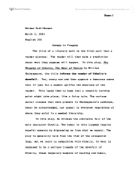Additionally, the wife of bath mentioned virginity. Line 148 and 149 she said “I am not spiteful toward virginity. Let virgins be white bread of pure wheat-seed.” Clearly she did not disagree with it but rather believed it’s not for everyone. This is not only because she could not contain her sexual desires but because, as she put it; if they were all virgins then there won’t be anyone to reproduce new virgins. She explained that sexual organs were made not only to excrete waste materials out of our bodies or distinguishing males from females but for procreation purposes (lines 121-140). Because she has so much experience in life, she also believes that the sexual organs are there for pleasure.
Furthermore, the wife of Bath used sex to exploit men. She used her body as an instrument in order to gain control or sovereignty over her husbands. She loved power as she boldly bragged in line 226, “So well I ruled them, by my law and sentence…” She believed women desire complete control over their husbands and for a marriage to work they have to have it. She arrogantly explained how she manipulated her first three rich husbands by teasing them in bed to the point that they would give her money and gifts. (Husband number four couldn’t be controlled as much, perhaps because he had a mistress.) The wife of Bath knew what men wanted and thus used her body effectively to achieve her goals and get whatever she wanted whether is was monetary gift, attention or control. In lines 205-210 and again in lines 409-414, detailing her evil behavior, she said “In bed they met their grief in fullest measure. There I would scold; I would not do their pleasure….Till he agreed to square accounts and pay...” This was her major reason she used sex to her three husbands of whom she never loved. Ironically, the very thing that she used to control her husbands ended up controlling her when she married husband number five. This young husband was brutal and abused her physically; nevertheless he would always make it up to her in bed. Unlike the other husbands, the fifth one was poor, young, uncontrollable and good in bed. His characters resembled the wife of bath herself when she was in her prime and perhaps that was the reason she loved him truly (She met her match). She admits that she never loved her other four husbands. It is only during the time with her last husband when the wife of Bath recognized superiority of sacred love and attained it but only for a short time till her 5th husband died.
Consequently, the wife of Bath’s attitudes toward sex greatly restricts life and happiness in a modern sense. She went against today’s feministic views in two major points. One is that she used sex to exploit men to achieve sovereignty and attain money and gifts for personal profit. .She is a selfish woman who thought of herself only and did not fight for the rights or greater good of all women. “Why task myself to spoil them or to please unless for my own profit and my ease?” she claimed in line 219-220 and also in line 418 “For victory their cravings I endured...”
Secondly, she confirms some of the negative medieval stereotypes against women. Back then women ware regarded as deceitful, lewdness and weak creatures etc. The wife of Bath was clearly a deceitful manipulator of men. As explained earlier, she used her body to get whatever she wanted. She was lewd because she teased them and arrogantly bragged about it. Thought one would argue that this woman was clever in achieving her goals (even though her methods are looked down upon) she was not well educated. She did not present her arguments sophisticatedly but rather in an arrogant and attention-seeking manner. She had some knowledge of the bible although she gave contradictory scriptures or presented scriptures that she herself did not understand completely want they meant. For instance, when she tried to defend her point of multiple marriages, she gave a bible example of a Samaritan woman. After explaining what Jesus said to this Samaritan woman, the wife of bath admitted in line 20, “But what he meant is more than I can say.” Her love of attention caused her to say things without thoroughly thinking about them. She also contradicted herself when she claimed to love sex, but only used it to manipulate men and pleasure men but not herself. She was weak as well in a sense that she could not leave her husband even though he was abusive. Love made her weak. Even in today’s’ society many strong independent women are weak when it comes to love, and therefore continue to stay in abusive relationships. Physical abuse to women is one of the major things feminists fight against.
In conclusion, though the medieval society regarded the wife of Bath’s sexual attitudes as unconventional and though her methods were solely for her own benefits, she was not entirely hopeless. She was courageous enough to stand up for what she believed as supposed to the many who just follow whatever law there is. One other thing is that, despite the fact that she was obviously not a feminist, she unknowingly maintained one feministic view, which is sexual freedom.







